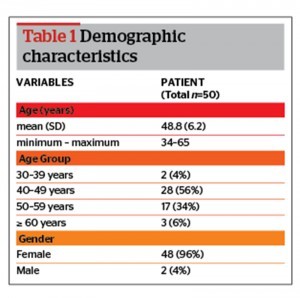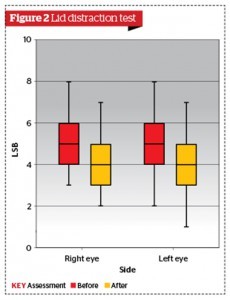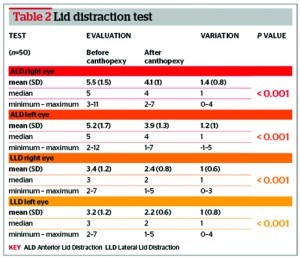Materials and methods
A prospective, randomised controlled surgical trial was conducted between April 2005 and May 2007 at the Federal University of São Paulo’s oculoplastic surgery sector. Fifty consecutive cosmetic surgery patients were recruited preoperatively through the oculoplastic surgery service. Subjects were approached for voluntary participation in the study after a decision to proceed with surgery had been made. All patients who agreed to participate signed a consent form approved by a human subjects review board (ethical committee) at the university (UNIFESP/EPM). The subjects were between 30 and 65 years of age at the time of surgery.
The author operated on all the patients, saw them at regular intervals, and took photographs at 4 weeks, 3 months, 6 months and 1 year after the procedure.
Canthopexy
There are two types of canthopexies: with or without canthotomy (canthoplasty)1–4,6–8,13–16. In 1983, McCord17 was the first to use a variation of this technique to avoid complications in aesthetic blepharoplasties. In 1987, Lisman18 began using tarsal suspension in blepharoplasties.
Canthopexy without canthotomy allows for the correction of eyelid laxity while preserving the anatomic integrity of the canthus, avoiding eyelid shortening, and reducing morbidity. Most of these techniques use transposition of a muscular or dermomuscular flap, or they release the lateral canthal tendon with a transposition through a suborbicular tunnel toward the periosteum of the lateral orbital rim.
For the study, a single-armed 5-0 monofilament non-absorbable suture was used to suture the tarsal plate and lateral retinaculum to the lateral orbital rim periosteum. The mattress suture was placed through the periosteum within the lateral orbital rim to maintain the posterior position of the lid margin against the globe. The vertical position of the lateral canthal suture was dependent on eye prominence and pre-existing canthal tilt.
The orbicularis muscle suspension was carried out by suturing the preseptal orbicularis muscle (attached to the lower skin flap) to the inferior aspect of the periosteum of the lateral orbital rim with a single stich of 6-0 Vicryl (Ethicon Endo-Surgery, Inc., São José dos Campos, Brazil). A tension-free closure was achieved with a 6-0 nylon suture.
Statistical analysis
The data were analysed using multivariate analysis of variance procedures to compare the repeated measured effects in the preoperative and postoperative data with the Wilcoxon test. Statistical analysis was carried out with Statistical Package for Social Science (SPSS) version 16.0 for Mac (SPSS, Inc., Chicago, USA).
Results
Between April 2005 and May 2007, 50 patients underwent transcutaneous lower-lid blepharoplasty, performed by the author, at the Federal University of São Paulo’s oculoplastic surgery sector.
Table 1 lists the baseline demographic characteristics of the studied population. The mean age of the study population was 48.8 years (range 34–65 years). The population’s gender was predominantly female (96%). The follow-up period was at least 1 year (a range of 364–547 days), as shown in Figure 1.
Canthal support was performed in all patients and the results were statistically significant (P<0.001), as seen in Figure 2 and Table 2.







